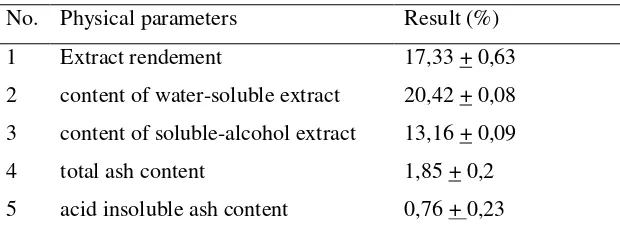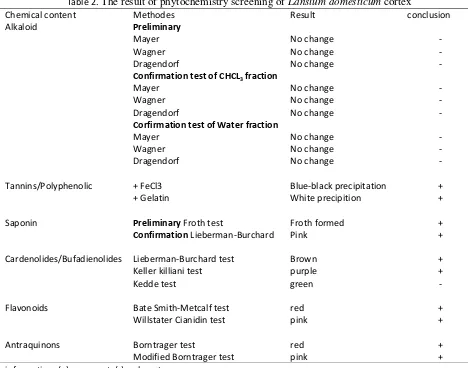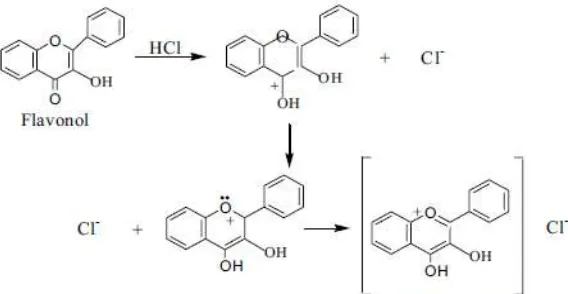Volume 8, No.2, Agustus 2015 41
Lansium domesticum cortex was empirically used by people on the Pakuli region of Palu to reduced pain on malaria treatment. The analysis of chemicals and physical properties Lansium domesticum cortex has been conducted. The aim of this research was to analyze chemicals and physical properties of Lansium domesticum cortex. The physical properties were rendement, water soluble compound content, water in-soluble compound content, total ash content, acid in-soluble ash content. The chemicals properties comprised chemical analysis of the constituent of Lansium domesticum cortex. Based on this study, we found that Lansium domesticum cortexcontains saponin, flavonoide, tannin and antraquinone. The extract rendement by 70% alcohol was 17,33 + 0,63%, water soluble compound content was 20,42 + 0,08%, water in-soluble compound content was 13,16 + 0,09%, total ash content was 1,85+ 0,20% and acid in-soluble ash content was 0,76 + 0,23% respectively.
Key words: Lansium domesticum cortex, chemicals, physical properties
INTRODUCTION
Malaria is a life-threatening disease caused by the Plasmodium parasite that is transmitted through the
bites of infected mosquitoes. Around half of the world’s population is at risk of malaria and there were around 240 million cases in 2008 (Dharani, 2010). Malaria is becoming more resistant to a number of current drugs and is on the increase because of the global warming process (Martin and Lefebvre, 1995). Thus, many communities who live in endemic areas, have started to look for malaria remedies from plants in their local environments (Miliken, 1997).
One of the effort to find malaria remedies is discovering new antimalaria drugs, which could be started by looking for plants that are traditionally used as antimalarial herbs. The use of traditional medicine in Indonesia is part of national culture and it have been used for decades (Anonymous, 2007).
Lansium domesticum is a higher tree, commonly called “kokosan’’ in Indonesia and widely distributed in Southeast Asian countries. Three varieties of L. domesticum that have been widely known namely duku, langsat and kokosan. Hence, for practical purpose, Maberley et al. (1995) suggested to write L. domesticum cv langsat or L. domesticum ‘langsat’ when referring to langsat variety. These three varieties are widely known to the local fruit market and can be distinguished mainly on the basis of their fruit morphology. Among of this varieties, langsat and kokosan are less preferable since it has a sour taste. Lansium domesticum cortex (family Meliaceae) was empirically used by people on the Pakuli region of Palu Central Sulawesi to treat malaria. The folk boiled Lansium domesticum cortex with water to reduce pain and fever.
Volume 8, No.2, Agustus 2015 42
pharmacological effects on animal model. Phytochemical screening approach involves the qualitative analysis of chemical constituents in plants (roots, stems, leaves, flowers, fruits, seeds), especially the content of bioactive secondary metabolites, namely alkaloids, anthraquinones, flavonoids, cardiac glycosides, coumarins, saponins (steroid and triterpenoid), tannin (polifenolat), essential oils (terpenoids), and iridoids.
The aims of this study was to analyse the chemicals and physical properties of Lansium domesticum cortex which was used by people on the Pakuli region to treat malaria.
MATERIAL AND METHODS
Material. Lansium domesticum cortex, from Pakuli, Palu, Central Sulawesi, ethanol (Merck), HCl (Merck), H2SO4 (Merck), NH3 (Merck), NaCl (Merck), chloroform (Merck), anhydrous Na2SO4 (Merck),
Glacial acetic acid (Merck), Benzene (Merck), Mg metal (Reidel de Haen), Mayer's reagent, Wagner's reagent, Dragendorff reagent, AlCl3 (Merck), FeCl3 (Merck), Gelatin reagent, Acetone (Merck),
n-Butanol (Merck), ethyl acetate (Merck).
Methods. This study is laboratory experimental analysis. The Lansium domesticum cortex was obtained from Pakuli traditional healers, Palu, Central Sulawesi. Analysis of material was done by observing several physics and chemistry parameters, including: rendement (70% alcohol), content of water-soluble extract, content of insoluble alcohol extract, total ash content, acid insoluble ash content, and phytochemical screening plants constituent by the spot test/color reaction (Santos, et al., 1978).
RESULT AND DISCUSSION
The results of physical parameters of Lansium domesticum cortex were shown in Table 1.
Tabel 1. Physical parameters of Lansium domesticum cortex
No. Physical parameters Result (%)
1 Extract rendement 17,33 + 0,63
2 content of water-soluble extract 20,42 + 0,08
3 content of soluble-alcohol extract 13,16 + 0,09
4 total ash content 1,85 + 0,2
5 acid insoluble ash content 0,76 + 0,23
Extract rendement content of water-soluble extract, content of soluble-alcohol extract were required to select the solvent extraction. Based on the Table 1, percentage of water-soluble was higher than alcohol-soluble content. This means the chemical constituent of Lansium domesticum cortex were more alcohol-soluble in water than alcohol.
Volume 8, No.2, Agustus 2015 43
Table 2. The result of phytochemistry screening of Lansium domesticum cortex
Chemical content Methodes Result conclusion
Tannins/Polyphenolic + FeCl3 Blue-black precipitation +
+ Gelatin White precipition +
Saponin Preliminary Froth test Froth formed +
Confirmation Lieberman-Burchard Pink +
Cardenolides/Bufadienolides Lieberman-Burchard test Brown +
Keller killiani test purple +
Kedde test green -
Flavonoids Bate Smith-Metcalf test red +
Willstater Cianidin test pink +
Antraquinons Borntrager test red +
Modified Borntrager test pink +
information: (+) = present, (-) = absent
Alkaloid test. Positive results on the Mayer's test was characterized by the formation of white precipitate. The sediment was performed due to a potassium-alkaloid. In Mayer reagent, a solution of mercury (II) chloride with potassium iodide will react to form a precipitate of red mercury (II) iodide. If potassium iodide is added excessively, it generates potassium tetraiodomercurate (II) (Svehla, 1990). Alkaloids contain lone pair electron in the nitrogen atom which can be used to form coordinate covalent bonds with metal ions (McMurry, 2004). In the alkaloid test with Mayer's reagent, nitrogen in the alkaloid reacts with metal ions K+ of potassium tetraiodomercurate(II) to form precipitation of potassium-alkaloid complex. A hypothetic reaction in Mayer test was shown in Figure 1.
Figure 1. Hypothetic reaction during Mayer test
Volume 8, No.2, Agustus 2015 44
form brown I3-ion. In the Wagner test, K+ metal ions form coordinate covalent bonds with nitrogen to generate precipitated complex potassium-alkaloid. Reactions that occur in test Wagner were showed in Figure 2.
Figure 2. Hypothetic reaction during Wagner test
Positive results on the Dragendorff test marked by the formation of brown to yellow precipitate. In Dragendorff reagent, Bi3+ ion from the bismuth nitrate reacts with potassium iodide to form a black precipitate Bismuth(III) iodide that dissolves in excess amount of potassium iodide to form potassium tetraiodobismutat (Svehla, 1990). In the alkaloid test with Dragendorff reagent, nitrogen (alkaloid compound) forms a coordinate covalent bond with the metal ion K+ to generate precipitate potasium alkaloid complex. Dragendorff hypothetic reactions were shown in Figure 3.
Figure 3. Hypothetic reaction during Dragendorff test
Tannin/Polyphenolic test. On tannin/polyphenolic test, tannin will precipitate gelatin to form solid copolymer which is not soluble in water (Harborne, 1996). This reaction is more sensitive to the addition of NaCl to enhance the salting of the tannin-gelatin.
Saponin test. The foam formation in the forth test showed hydrolyzed glycosides which has ability to generate foam in water (Rusdi, 1990). In addition to forth test, Lieberman-Burchard test was also conducted to characterize unsaturated sterols and triterpenes (Santos et al., 1978).
Cardenolide/bufadinolides test. Positive results in the Kiliani-Keller test indicates the presence of a deoxy sugar of glycosides (Santos et al., 1978). The red color is formed due complex formation. Oxygen atom with a lone pair electron on the sugar group can donate electrons to the Fe3+ to form a complex compound. Keller Killiani hypothetic reaction shown on Figure 4.
Volume 8, No.2, Agustus 2015 45
Red Flavilium salt
The presence of cardenolide/bufadinolide can be detected also by Lieberman-Burchard test. It is a characteristic test for unsaturated sterols and triterpenes (Santos et al., 1978). Kedde test was performed to indicate the presence of unsaturated lactones (Santos, 1978). Hypothetic reaction in Kedde test was shown in Figure 5.
Figure 5. Hypothetic reaction during Kedde test
Flavonoid test. Wilstater cyanidin test was performed to detect compounds with -benzopyron structure. Orange colour on the Mertcalf Bate-Smith test and red color on the Wilstater test were the result of flavilium salt formation (Achmad, 1986) as shown in figure 6.
Figure 6. Hypothetic reaction during Flavonoid test
Antraquinone test. Brontrager test could not detect anthraquinone glycosides which are very stable or reduced forms of antranol derivatives. So, the test was modified by hydrolisis and oxidation of the sample prior to Brontrager test. Anthraquinones react with basic substances (-OH) to generate red, violet, green or purple characteristic color.
CONCLUSION
Based on this study, Lansium domesticum cortex were consisted of saponin, flavonoid, tannin and antraquinone. The extract rendement by 70% alcohol was 17,33 + 0,63%, water soluble compound content was 20,42 + 0,08%, water in-soluble compound content was 13,16 + 0,09%, total ash content was 1,85+ 0,20% and acid in-soluble ash content was 0,76 + 0,23%.
Volume 8, No.2, Agustus 2015 46
Anonymous, 2000, Parameter Standar Umum Ekstrak Tumbuhan Obat, hal: 1-19, Dirjen POM, Jakarta.
Anonymous, 2007. KepMenkes No. 381/Menkes/SK/III/ 2007, tentang :Kebijakan Obat Tradisional
Nasional (KOTRANAS)
Dharani N. and Yenesew A. 2010. Medicinal plants of East Africa: An illustrated guide. Publisher – Najma Dharani; in association with Drongo Editing & Publishing. ISBN 978-9966-05-167-8.
Fransworth N.R., 1996, Biological and Fitochemical Skrining of Plants, Jfarm.Sci
Harborne J. 1996. Metode Fitokimia: Penuntun Cara Modern Menganalisis Tumbuhan. Cetakan kedua. Penerjemah: Padmawinata, K. dan I. Soediro. Bandung: Penerbit ITB.
Maberley D.J., Pannell C.M., Sing A.M., 1995, Meliaceae. Flora malesiana ser I 12: 1-407
Martin P.H. and Lefebvre M.A., 1995, Malaria and Climate: sensitivity of malaria potential transmission to Climate, R. Swedish Acad. Sci. 24: 200-207.
McMurry J. and Fay R.C. 2004. McMurry Fay Chemistry. 4th edition. Belmont, CA.: Pearson Education International
Miliken W. 1997. Malaria and anti-malarial plants in Roraima, Brazil. Trop. Doct. 27: 20-25.
Rao Y. and Xiang. 2009. Determination of Total Ash and Acid-Insoluble asg of Chinese herbal medicine Prunella apice by near infrared spectroscopy. Pharm.Soc. Jpn., 129:881-886
Rusdi. 1990. Tetumbuhan Sebagai Sumber Bahan Obat. Padang: Pusat Penelitian Universitas Andalas.
Santos A.F., Guevera B.Q., Mascardo A.M and Estrada C.Q. 1978. Phytochemical, Microbiological and Pharmacological, Screening of Medical Plants. Manila: Research Center University of Santo Thomas.



